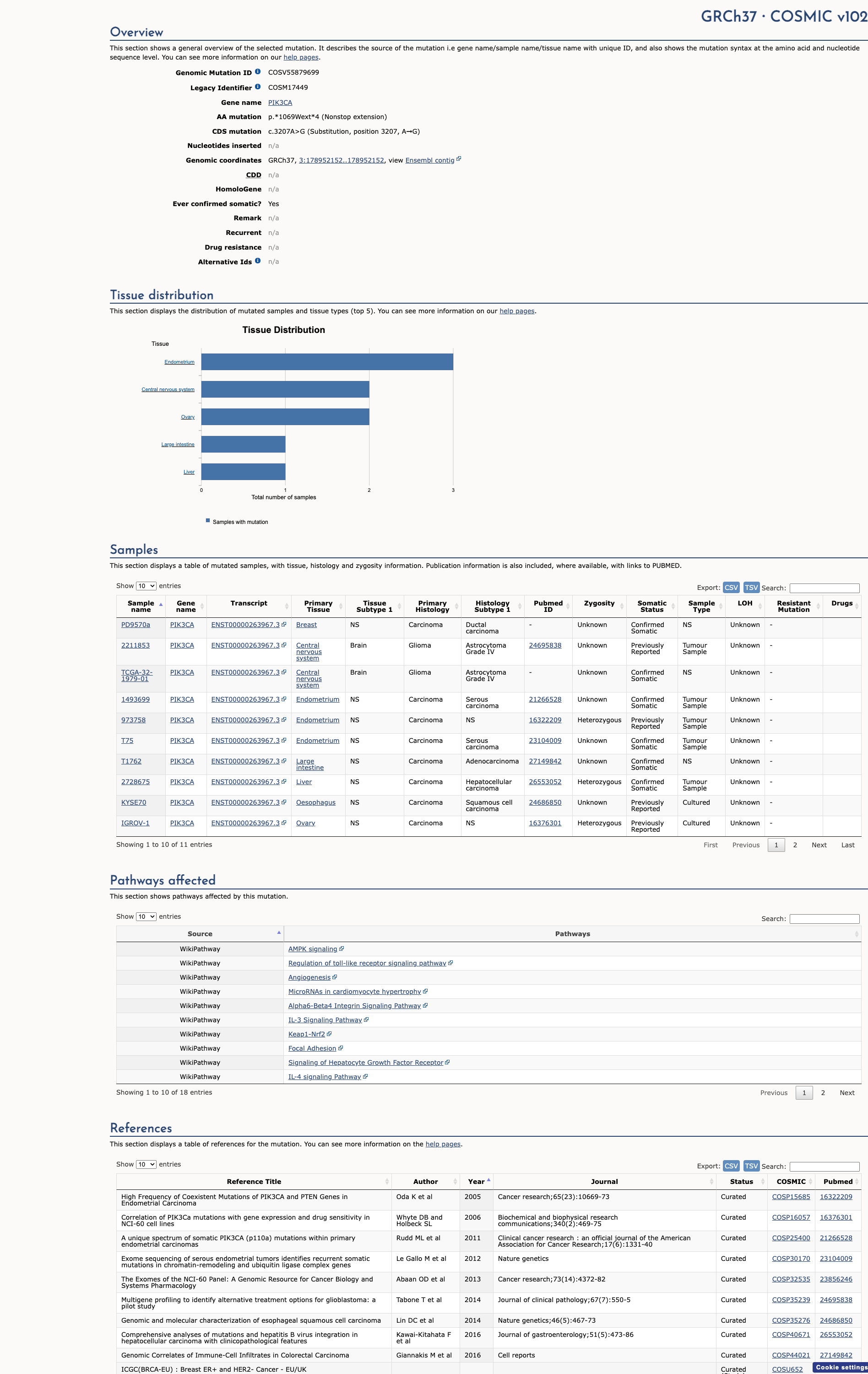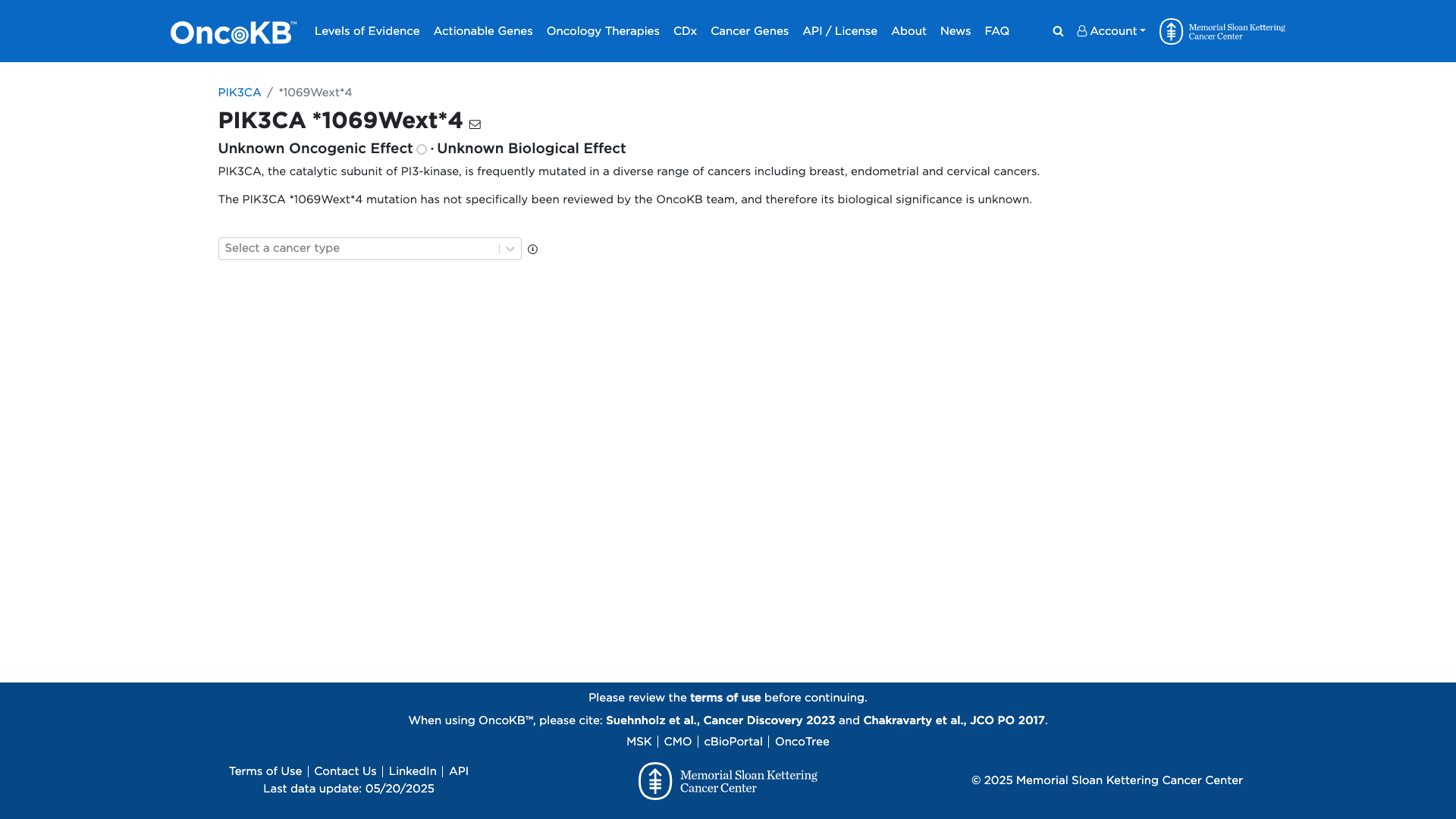PIK3CA c.3207A>G, p.Ter1069TrpextTer4
NM_006218.4:c.3207A>G
COSMIC ID: COSM17449
Likely Pathogenic
The NM_006218.4:c.3207A>G (p.*1069Wext*4) variant in PIK3CA results in a C-terminal extension but lacks evidence of loss or gain of function. It is absent from controls (PM2) and alters protein length (PM4), but no other criteria are met. Therefore, classification is Variant of Uncertain Significance.
ACMG/AMP Criteria Applied
PM2
PM4
Genetic Information
Gene & Transcript Details
Gene
PIK3CA
Transcript
NM_006218.4
MANE Select
Total Exons
21
Strand
Forward (+)
Reference Sequence
NC_000003.11
Alternative Transcripts
| ID | Status | Details |
|---|---|---|
| NM_006218.2 | Alternative | 21 exons | Forward |
| NM_006218.3 | Alternative | 21 exons | Forward |
Variant Details
HGVS Notation
NM_006218.4:c.3207A>G
Protein Change
*1069Wext*4
Location
Exon 21
(Exon 21 of 21)
5'Exon Structure (21 total)3'
Functional Consequence
Loss of Function
Related Variants
Alternate Identifiers
COSM17449
Variant interpretation based on transcript NM_006218.4
Genome Browser
Loading genome browser...
HGVS InputNM_006218:c.3207A>G
Active Tracks
ConservationRefSeqClinVargnomAD
Navigation tips: Use mouse to drag and zoom. Click on features for details.
Clinical Data
Population Frequency
Global Frequency
0.0 in 100,000
Extremely Rare
Global: 0.0%
0%
0.05%
0.1%
1%
5%
10%+
ACMG Criteria Applied
PM2
This variant is not present in gnomAD (PM2 criteria applies).
Classification
Unknown
Publications (0)
No publication details.
Clinical Statement
Functional Impact
Functional Domain
Hotspot Status
Not a hotspot
Domain Summary
This variant is not located in a mutational hotspot or critical domain (0 mutations).
Related Variants in This Domain
Computational Analysis
Pathogenicity Predictions
Predictor Consensus
Mixed/VUS
PP3 Applied
No
Additional Predictors
Benign:
CADD: 1.56
Neutral: Show all
VCEP Guidelines
Applied ACMG/AMP Criteria (VCEP Specific) VCEP Guidelines
PVS1
PVS1 (Not Applied) Strength Modified
According to standard ACMG guidelines, the rule for PVS1 is: 'Null variant (nonsense, frameshift, canonical ±1 or 2, start codon, splice site) in a gene where loss of function is a known mechanism of disease.' The evidence for this variant shows: a stop‐loss variant resulting in a C‐terminal extension rather than true loss of function. Therefore, this criterion is not applied at Not Applied strength because the variant does not create a null allele.
PS1
PS1 (Not Applied) Strength Modified
According to standard ACMG guidelines, the rule for PS1 is: 'Same amino acid change as an established pathogenic variant regardless of nucleotide change.' The evidence for this variant shows: no previously described pathogenic variant with the same protein effect. Therefore, this criterion is not applied at Not Applied strength because there is no matching amino acid change reported.
PS2
PS2 (Not Applied) Strength Modified
According to standard ACMG guidelines, the rule for PS2 is: 'De novo (both maternity and paternity confirmed) in a patient with the disease and no family history.' The evidence for this variant shows: no information on parental testing or de novo occurrence. Therefore, this criterion is not applied at Not Applied strength because de novo status is not established.
PS3
PS3 (Not Applied) Strength Modified
According to standard ACMG guidelines, the rule for PS3 is: 'Well‐established in vitro or in vivo functional studies supportive of a damaging effect.' The evidence for this variant shows: no functional studies available. Therefore, this criterion is not applied at Not Applied strength because functional data are lacking.
PS4
PS4 (Not Applied) Strength Modified
According to standard ACMG guidelines, the rule for PS4 is: 'The prevalence of the variant in affected individuals is significantly increased compared with controls.' The evidence for this variant shows: no case‐control or cohort data. Therefore, this criterion is not applied at Not Applied strength because case‐level or statistical data are unavailable.
PM1
PM1 (Not Applied) Strength Modified
According to VCEP guidelines, the rule for PM1 is: 'Residues affecting critical functional domains provided in Table 4 for each gene.' The evidence for this variant shows: codon 1069 is not located in a VCEP‐defined critical domain or hotspot. Therefore, this criterion is not applied at Not Applied strength because the residue is not within a critical functional region.
PM2
PM2 (Supporting) Strength Modified
According to VCEP guidelines, the rule for PM2 is: 'Absent/rare from controls in an ethnically‐matched cohort population sample (≥1).' The evidence for this variant shows: absent from gnomAD and other population databases (MAF = 0%). Therefore, this criterion is applied at Supporting strength because the variant is absent from controls.
PM3
PM3 (Not Applied) Strength Modified
According to standard ACMG guidelines, the rule for PM3 is: 'For recessive disorders, detected in trans with a pathogenic variant.' The evidence for this variant shows: PIK3CA-associated disease is not recessive and there are no observations in trans. Therefore, this criterion is not applied at Not Applied strength because trans occurrence is not relevant.
PM4
PM4 (Moderate)
According to standard ACMG guidelines, the rule for PM4 is: 'Protein length changes as a result of in-frame indels or stop-loss variants.' The evidence for this variant shows: a stop-loss variant resulting in a 4–amino acid C-terminal extension. Therefore, this criterion is applied at Moderate strength because the variant causes a protein length change.
PM5
PM5 (Not Applied) Strength Modified
According to standard ACMG guidelines, the rule for PM5 is: 'Novel missense change at an amino acid residue where a different missense change is pathogenic.' The evidence for this variant shows: not a missense variant and no pathogenic missense at this residue. Therefore, this criterion is not applied at Not Applied strength.
PM6
PM6 (Not Applied) Strength Modified
According to standard ACMG guidelines, the rule for PM6 is: 'Assumed de novo, but without confirmation of paternity/maternity.' The evidence for this variant shows: no de novo data. Therefore, this criterion is not applied at Not Applied strength.
PP1
PP1 (Not Applied) Strength Modified
According to standard ACMG guidelines, the rule for PP1 is: 'Cosegregation with disease in multiple affected family members.' The evidence for this variant shows: no segregation data. Therefore, this criterion is not applied at Not Applied strength.
PP2
PP2 (Not Applied) Strength Modified
According to VCEP guidelines, the rule for PP2 is: 'Missense constraint z-score >3.09 for PIK3CA.' The evidence for this variant shows: the variant is not missense. Therefore, this criterion is not applied at Not Applied strength.
PP3
PP3 (Not Applied) Strength Modified
According to standard ACMG guidelines, the rule for PP3 is: 'Multiple lines of computational evidence support a deleterious effect.' The evidence for this variant shows: CADD score 1.56, neutral MutationTaster, minimal SpliceAI impact. Therefore, this criterion is not applied at Not Applied strength because in silico tools do not support a damaging effect.
PP4
PP4 (Not Applied) Strength Modified
According to standard ACMG guidelines, the rule for PP4 is: 'Patient phenotype or family history is highly specific for a disease with a single genetic etiology.' The evidence for this variant shows: phenotype data not provided. Therefore, this criterion is not applied at Not Applied strength.
PP5
PP5 (Not Applied) Strength Modified
According to standard ACMG guidelines, the rule for PP5 is: 'Reputable source reports the variant as pathogenic.' The evidence for this variant shows: absent from ClinVar. Therefore, this criterion is not applied at Not Applied strength.
BA1
BA1 (Not Applied) Strength Modified
According to VCEP guidelines, the rule for BA1 is: 'Allele frequency >0.0926%.' The evidence for this variant shows: MAF = 0%. Therefore, this criterion is not applied at Not Applied strength.
BS1
BS1 (Not Applied) Strength Modified
According to VCEP guidelines, the rule for BS1 is: 'Allele frequency >0.0185%.' The evidence for this variant shows: MAF = 0%. Therefore, this criterion is not applied at Not Applied strength.
BS2
BS2 (Not Applied) Strength Modified
According to VCEP guidelines, the rule for BS2 is: '≥3 homozygous or heterozygous occurrences in well‐phenotyped individuals.' The evidence for this variant shows: no occurrences. Therefore, this criterion is not applied at Not Applied strength.
BS3
BS3 (Not Applied) Strength Modified
According to VCEP guidelines, the rule for BS3 is: 'Well‐established functional studies show lack of damaging effect.' The evidence for this variant shows: no functional studies available. Therefore, this criterion is not applied at Not Applied strength.
BS4
BS4 (Not Applied) Strength Modified
According to standard ACMG guidelines, the rule for BS4 is: 'Lack of segregation in affected members of a family.' The evidence for this variant shows: no segregation data. Therefore, this criterion is not applied at Not Applied strength.
BP1
BP1 (Not Applied) Strength Modified
According to standard ACMG guidelines, the rule for BP1 is: 'Missense variant in a gene where only truncating variants cause disease.' The evidence for this variant shows: a stop‐loss variant, not missense. Therefore, this criterion is not applied at Not Applied strength.
BP2
BP2 (Not Applied) Strength Modified
According to standard ACMG guidelines, the rule for BP2 is: 'Observed in trans with a pathogenic variant for a dominant disorder or in cis for any.' The evidence for this variant shows: no such observations. Therefore, this criterion is not applied at Not Applied strength.
BP3
BP3 (Not Applied) Strength Modified
According to standard ACMG guidelines, the rule for BP3 is: 'In-frame indels in a repetitive region without a known function.' The evidence for this variant shows: not an indel nor in a repetitive region. Therefore, this criterion is not applied at Not Applied strength.
BP4
BP4 (Not Applied) Strength Modified
According to VCEP guidelines, the rule for BP4 is: 'Synonymous, intronic, or UTR variants with two of three splicing tools predicting no impact.' The evidence for this variant shows: a coding stop-loss variant. Therefore, this criterion is not applied at Not Applied strength.
BP5
BP5 (Not Applied) Strength Modified
According to standard ACMG guidelines, the rule for BP5 is: 'Variant found in a case with an alternate molecular basis for disease.' The evidence for this variant shows: no alternate molecular basis reported. Therefore, this criterion is not applied at Not Applied strength.
BP6
BP6 (Not Applied) Strength Modified
According to standard ACMG guidelines, the rule for BP6 is: 'Reputable source reports the variant as benign.' The evidence for this variant shows: absent from ClinVar. Therefore, this criterion is not applied at Not Applied strength.
BP7
BP7 (Not Applied) Strength Modified
According to VCEP guidelines, the rule for BP7 is: 'Synonymous changes at non‐conserved nucleotides with no splicing impact.' The evidence for this variant shows: a coding stop‐loss. Therefore, this criterion is not applied at Not Applied strength.



